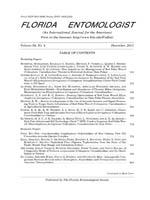Weeping fig, Ficus benjamina L. (Moraceae) is an ornamental plant species grown worldwide. In Mexico, it is one of the most widely used ornamentals in urban green areas. Leaves of the tree are damaged by the thrips Gynaikothrips uzeli Zimmerman (Cambero et al. 2010). Thrips feed on leaf terminals and inject toxins causing deformed leaves and gall formation (Held et al. 2005; Retana-Salazar & Sánchez-Chacón 2009). Chemical control of Gynaikothrips spp. is possible (Held & Boyd 2008), but insecticides should be used wisely in order to preserve associated natural enemies (Wheeler et al. 2007). In Mexico, Montandoniola confusa Streite & Matocq and Androthrips ramachandrai (Karny) have been found to be predators of Gynaikothrips spp (Cambero et al. 2010). In North America north of Mexico, A. ramachandrai, Montandoniola moraguesi Puton and Thripastichus gentilei (Del Guercio) are reported natural enemies (Held et al. 2005; Held & Boyd 2008).
Microbial control could be integrated with natural enemies as an alternative to insecticides. Entomopathogenic fungi (Hyphomycetes) infecting thrips have been described, especially on Frankliniella occidentalis (Pergande) and Thrips tabaci (Lindeman) (Gouli et al. 2008; Thungrabeab et al. 2006). The Hyphomycetes are common and well known soil-borne pathogens in nature, with a wide range of insect hosts, and are considered excellent biological control agents (Gouli et al. 2008). Evaluations of entomopathogenic fungi noticeably are absent from previous research on control of G. uzeli (Held & Boyd 2008) or recent reviews (Held et al. 2005). The objective of this study was to test isolates of Beauveria bassiana (Balsamo) Vuillemin, Metarhizium anisopliae (Metschnikoff), and Paecilomyces fumosoroseus (Wize) against larvae and adults of G. uzeli under laboratory conditions.
Fig. 1.
Gynaikothrips uzeli specimens infected with entomopathogenic fungi; a) Metarhizium anisopliae Ma-C;

Thrips used in bioassays were collected from trees of F. benjamina located in gardens of the Universidad Autónoma de Nayarit, in Tepic, Nayarit, Mexico, located at 21°29′18.73″N, 104°53′25″W and 944 masl, and were transferred to the Parasitology Department of the Universidad Autónoma Agraria Antonio Narro, Mexico. Thrips were identified by M. S. Jhonathan Cambero Campos. Entomopathogenic fungi were obtained from different hosts (Table 1) and were maintained and propagated on potato dextrose agar with 2% yeast extract (PDAY) that was supplemented with corn liquor to obtain pH 6.0. Purified fungi were identified according to their micro- and macroscopic characteristics (Humber 1997). Spores were stored under aseptic conditions in 0.05% Tween 80 sterile distilled water solution at pH 6.0. Spore viability ranged from 98 to 100% and was evaluated one day before bioassay setup by spreading 10 µL of each spore suspension onto PDAY in a Petri dish. After 24 h of incubation at 25 ± 2 °C, percentage of spore germination was evaluated. A spore was considered viable if the germ tube was twice the length of the spore. Prior to thrips treatments, original spore suspensions were stirred for 2 min, and spore concentrations were determined with a hemacytometer (Blau Brand, Germany) and adjusted to the concentration used for each isolate (Table 1).
TABLE 1.
PERCENT MORTALITY (MEANS ± SD) OF GYNAIKOTHRIPS UZELI 9 DAYS AFTER TREATMENT WITH ISOLATES OF ENTOMOPATHOGENIC FUNGI IN MEXICO.

Leaves containing thrips (larvae and adults) were dipped in a spore suspension (5 × 107 to 2.5 × 1010 spores per mL) for 10 s (Lewis 1997) and left to dry at ambient temperature (28 °C). Controls were treated with 0.05% Tween 80 water solution. Treated thrips (either 1st and 2nd instar larvae or adults) were then transferred to uninfested leaves that had been washed in 0.5% sodium hypochlorite water solution to eliminate contaminants and fixed to a base of plaster (4 mm thick) on Petri dishes. Each dish contained one leaf and 20 larvae or 20 adults. Dishes were sealed with parafilm, placed on a sponge saturated with water, and stored at 25 ± 2 °C, a photoperiod of 14:10 h L:D, and 95% relative humidity. Mortality of G. uzeli was recorded daily for 9 days post-inoculation, and fungal infection was confirmed by the presence of mycelium and conidia on the insect cuticle, as observed under a microscope.
Percent mortality was corrected using Abbott's formula (Abbott 1925) before statistical analysis. The experiment was conducted in 3 replicates using a randomized complete block design with 6 treatments, where each treatment was an isolate of entomopathogenic fungi (a total of 180 larvae and 180 adults per treatment were tested). Mortality data were normalized using arcsine transformation and were analyzed using Statistical Analysis System (SAS 2002) for balanced Analysis of Variance (ANOVA). Means were separated by Tukey'ls test (P < 0.05).
Results showed that the 6 tested isolates were pathogenic to both stages of G. uzeli, and mycelial growth of fungi was observed on the cuticle of larvae and adults (Fig. 1). Mortality differed significantly (F = 72.09, df = 5, P < 0.001 for adults and F = 3.09, df = 5, P < 0.0001 for larvae) with isolates of B. bassiana (Bb-S1) and M. anisopliae (Ma-A) causing the highest mortality (Table 1). B. bassiana and M. anisopliae also have been reported as effective pathogens against F. occidentalis (Vestergaard et al. 1995) and T. tabaci (Thungrabeab et al. 2006; Gouli et al. 2008). We chose to test M. anisopliae, B. bassiana, and P. fumosoroseus due to their geographical distribution, host range, and potential as biological control agents. Although all tested isolates were pathogenic to G. uzeli, further research is needed to test methods and application equipment under field conditions. Thrips cause leaves to fold, which serves as protection, but may also complicate control.
SUMMARY
The biological activity of Beauveria bassiana (isolates Bb-S1, Bb-S2, and Bb-S3), Metarhizium anisopliae (Ma-A and Ma-C), and Paecilomyces fumosoroseus (Pf-4a) as biological control agents of the thrips Gynaikothrips uzeli was evaluated under laboratory conditions. Isolates Bb-S1 and Ma-A caused the highest mortality in both larvae and adults. Further research is needed to test methods and equipment for application under field conditions.





